Japanese vs Choctaw Community Comparison
COMPARE
Japanese
Choctaw
Social Comparison
Social Comparison
Japanese
Choctaw
2,662
SOCIAL INDEX
24.2/ 100
SOCIAL RATING
248th/ 347
SOCIAL RANK
2,496
SOCIAL INDEX
22.5/ 100
SOCIAL RATING
254th/ 347
SOCIAL RANK
Choctaw Integration in Japanese Communities
The statistical analysis conducted on geographies consisting of 167,674,801 people shows a substantial positive correlation between the proportion of Choctaw within Japanese communities in the United States with a correlation coefficient (R) of 0.595. On average, for every 1% (one percent) increase in Japanese within a typical geography, there is an increase of 0.160% in Choctaw. To illustrate, in a geography comprising of 100,000 individuals, a rise of 1,000 Japanese corresponds to an increase of 160.2 Choctaw.
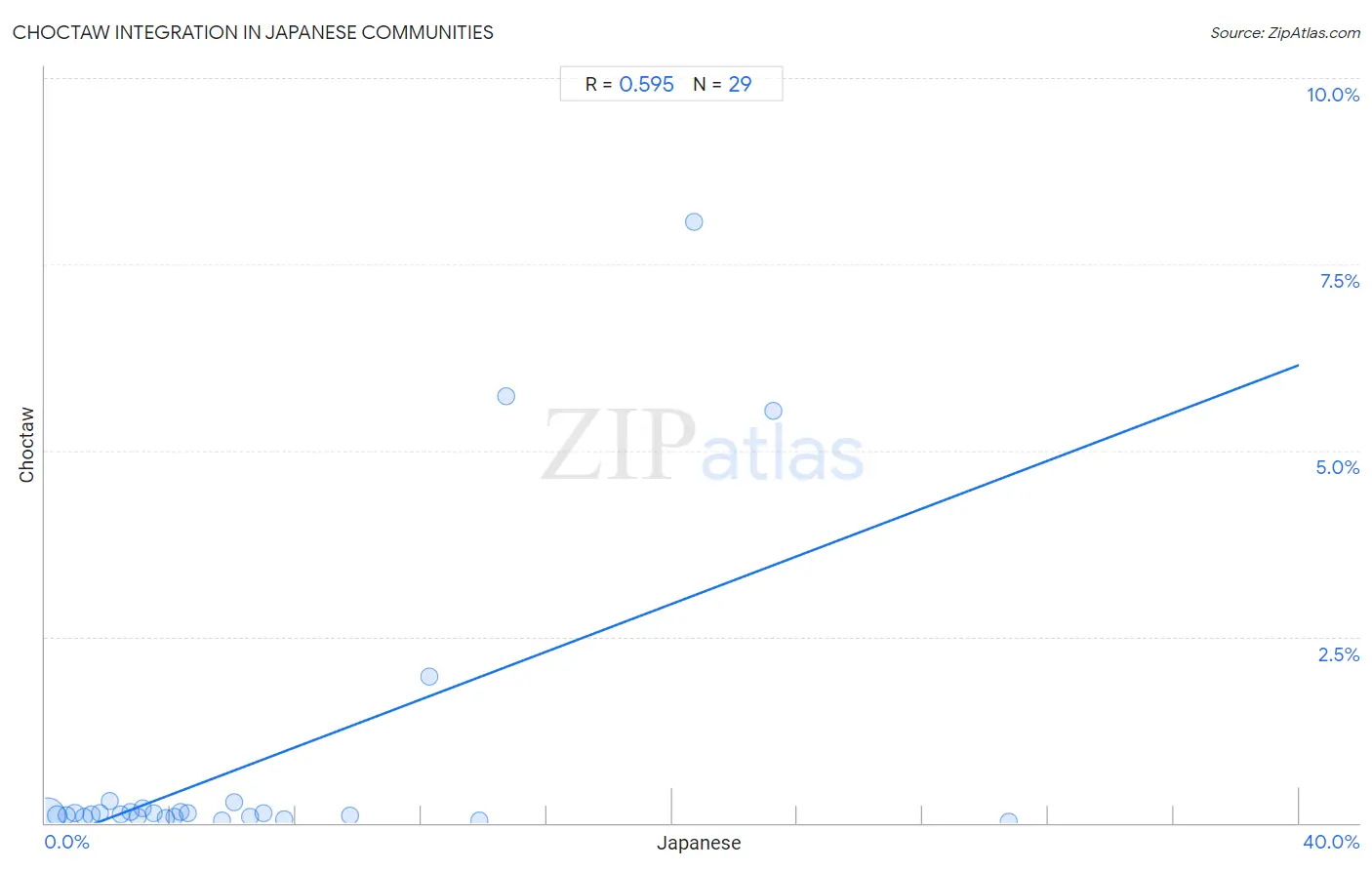
Japanese vs Choctaw Income
When considering income, the most significant differences between Japanese and Choctaw communities in the United States are seen in median household income ($83,395 compared to $69,947, a difference of 19.2%), wage/income gap (23.8% compared to 28.1%, a difference of 18.3%), and householder income ages 45 - 64 years ($96,834 compared to $82,287, a difference of 17.7%). Conversely, both communities are more comparable in terms of median male earnings ($51,473 compared to $47,729, a difference of 7.9%), householder income over 65 years ($57,919 compared to $53,060, a difference of 9.2%), and per capita income ($39,870 compared to $35,999, a difference of 10.7%).

| Income Metric | Japanese | Choctaw |
| Per Capita Income | Tragic $39,870 | Tragic $35,999 |
| Median Family Income | Tragic $97,288 | Tragic $84,835 |
| Median Household Income | Fair $83,395 | Tragic $69,947 |
| Median Earnings | Tragic $44,825 | Tragic $40,270 |
| Median Male Earnings | Tragic $51,473 | Tragic $47,729 |
| Median Female Earnings | Tragic $38,528 | Tragic $33,775 |
| Householder Age | Under 25 years | Good $52,365 | Tragic $45,450 |
| Householder Age | 25 - 44 years | Poor $91,624 | Tragic $78,168 |
| Householder Age | 45 - 64 years | Poor $96,834 | Tragic $82,287 |
| Householder Age | Over 65 years | Tragic $57,919 | Tragic $53,060 |
| Wage/Income Gap | Exceptional 23.8% | Tragic 28.1% |
Japanese vs Choctaw Poverty
When considering poverty, the most significant differences between Japanese and Choctaw communities in the United States are seen in single father poverty (15.2% compared to 20.7%, a difference of 36.0%), child poverty under the age of 5 (18.1% compared to 23.5%, a difference of 30.1%), and single male poverty (13.1% compared to 17.0%, a difference of 29.7%). Conversely, both communities are more comparable in terms of receiving food stamps (14.1% compared to 13.6%, a difference of 3.5%), seniors poverty over the age of 75 (13.3% compared to 12.5%, a difference of 6.5%), and seniors poverty over the age of 65 (12.2% compared to 11.4%, a difference of 7.0%).
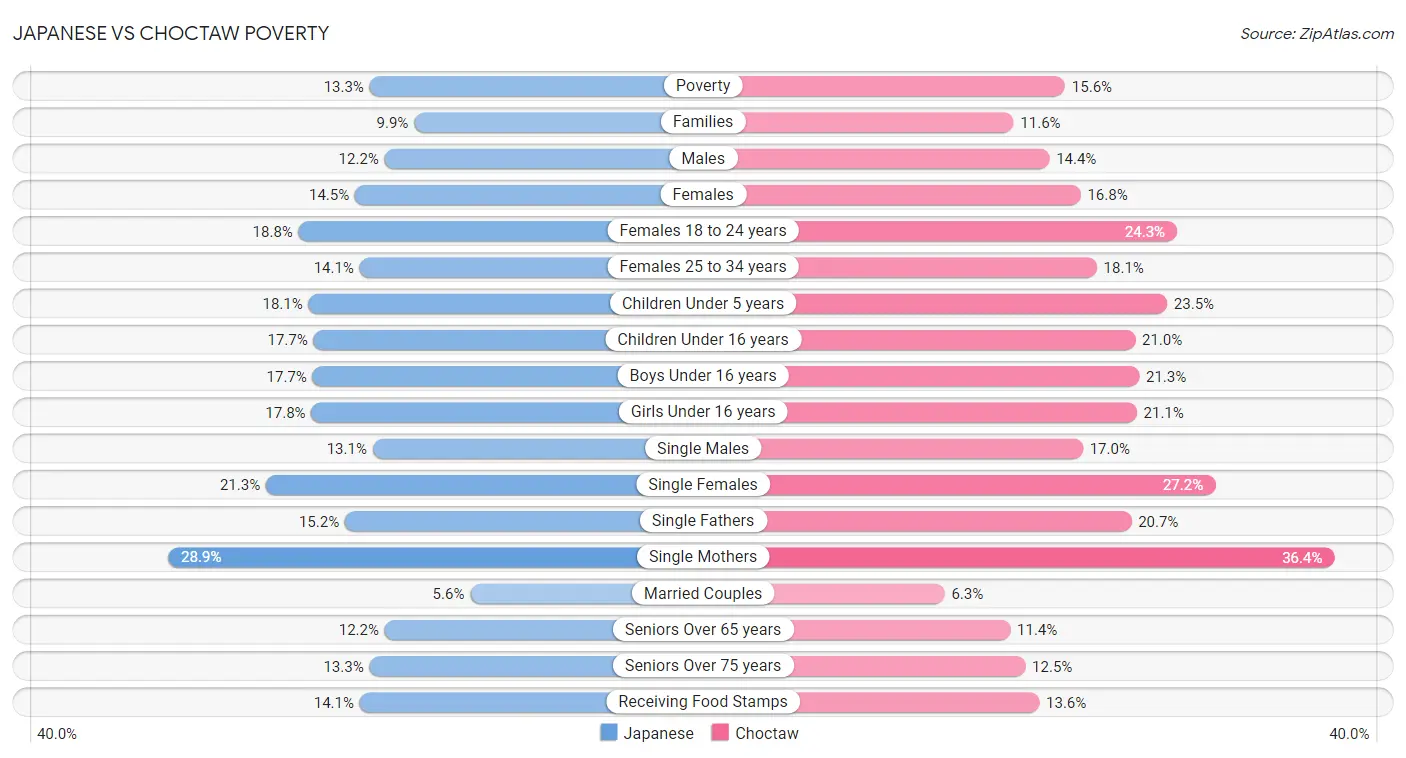
| Poverty Metric | Japanese | Choctaw |
| Poverty | Tragic 13.3% | Tragic 15.6% |
| Families | Tragic 9.9% | Tragic 11.6% |
| Males | Tragic 12.2% | Tragic 14.4% |
| Females | Tragic 14.5% | Tragic 16.8% |
| Females 18 to 24 years | Exceptional 18.8% | Tragic 24.3% |
| Females 25 to 34 years | Poor 14.1% | Tragic 18.1% |
| Children Under 5 years | Poor 18.1% | Tragic 23.5% |
| Children Under 16 years | Tragic 17.7% | Tragic 21.0% |
| Boys Under 16 years | Tragic 17.7% | Tragic 21.3% |
| Girls Under 16 years | Tragic 17.8% | Tragic 21.1% |
| Single Males | Poor 13.1% | Tragic 17.0% |
| Single Females | Fair 21.3% | Tragic 27.2% |
| Single Fathers | Exceptional 15.2% | Tragic 20.7% |
| Single Mothers | Good 28.9% | Tragic 36.4% |
| Married Couples | Tragic 5.6% | Tragic 6.3% |
| Seniors Over 65 years | Tragic 12.2% | Poor 11.4% |
| Seniors Over 75 years | Tragic 13.3% | Fair 12.5% |
| Receiving Food Stamps | Tragic 14.1% | Tragic 13.6% |
Japanese vs Choctaw Unemployment
When considering unemployment, the most significant differences between Japanese and Choctaw communities in the United States are seen in unemployment among women with children under 6 years (7.5% compared to 9.8%, a difference of 30.9%), unemployment among women with children ages 6 to 17 years (8.4% compared to 9.9%, a difference of 17.6%), and unemployment among ages 30 to 34 years (5.9% compared to 6.4%, a difference of 9.2%). Conversely, both communities are more comparable in terms of unemployment among ages 45 to 54 years (4.7% compared to 4.7%, a difference of 0.92%), unemployment among seniors over 65 years (4.9% compared to 4.9%, a difference of 1.7%), and unemployment among ages 65 to 74 years (5.2% compared to 5.1%, a difference of 2.5%).
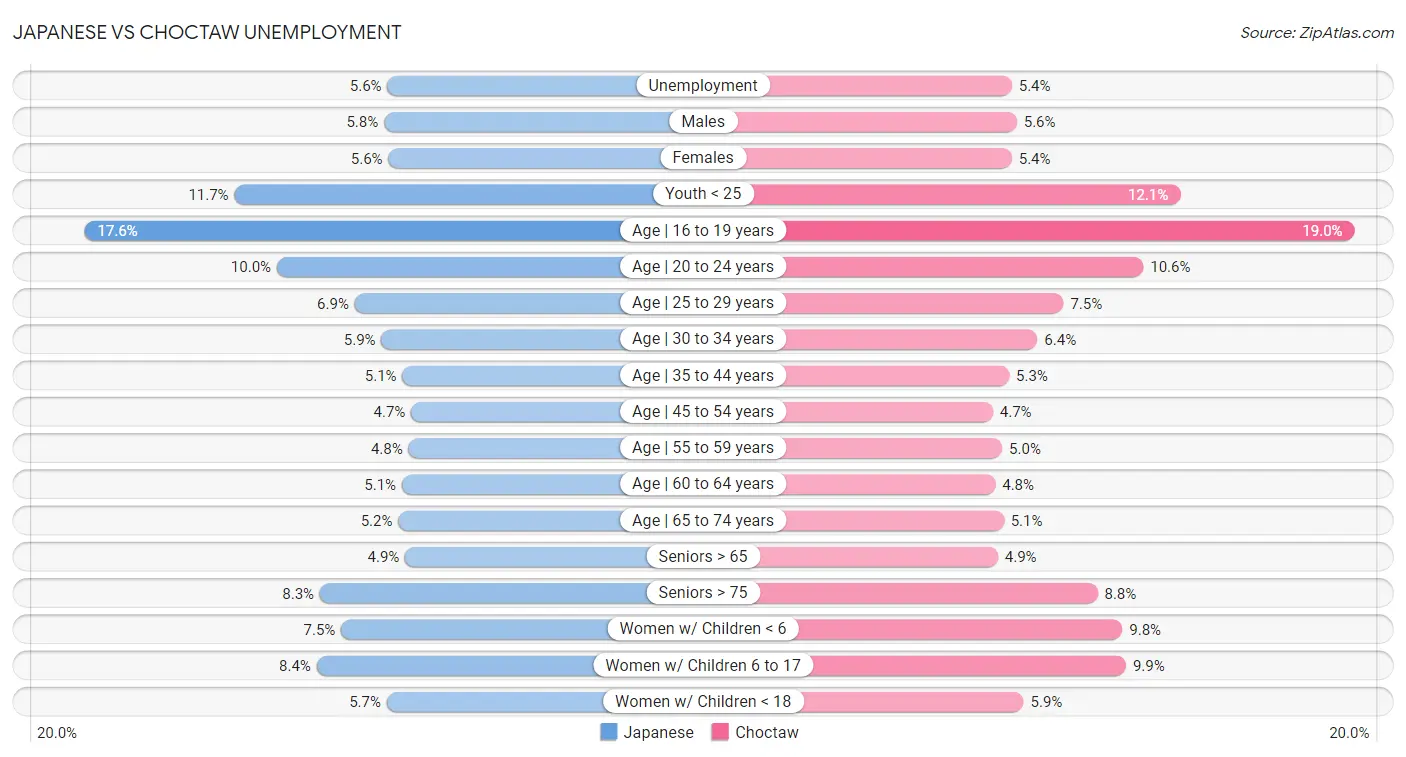
| Unemployment Metric | Japanese | Choctaw |
| Unemployment | Tragic 5.6% | Poor 5.4% |
| Males | Tragic 5.8% | Tragic 5.6% |
| Females | Tragic 5.6% | Poor 5.4% |
| Youth < 25 | Fair 11.7% | Tragic 12.1% |
| Age | 16 to 19 years | Average 17.6% | Tragic 19.0% |
| Age | 20 to 24 years | Exceptional 10.0% | Tragic 10.6% |
| Age | 25 to 29 years | Tragic 6.9% | Tragic 7.5% |
| Age | 30 to 34 years | Tragic 5.9% | Tragic 6.4% |
| Age | 35 to 44 years | Tragic 5.1% | Tragic 5.3% |
| Age | 45 to 54 years | Tragic 4.7% | Tragic 4.7% |
| Age | 55 to 59 years | Average 4.8% | Tragic 5.0% |
| Age | 60 to 64 years | Tragic 5.1% | Exceptional 4.8% |
| Age | 65 to 74 years | Exceptional 5.2% | Exceptional 5.1% |
| Seniors > 65 | Exceptional 4.9% | Exceptional 4.9% |
| Seniors > 75 | Exceptional 8.3% | Fair 8.8% |
| Women w/ Children < 6 | Good 7.5% | Tragic 9.8% |
| Women w/ Children 6 to 17 | Exceptional 8.4% | Tragic 9.9% |
| Women w/ Children < 18 | Tragic 5.7% | Tragic 5.9% |
Japanese vs Choctaw Labor Participation
When considering labor participation, the most significant differences between Japanese and Choctaw communities in the United States are seen in in labor force | age > 16 (65.8% compared to 61.5%, a difference of 7.1%), in labor force | age 20-64 (79.1% compared to 75.4%, a difference of 4.8%), and in labor force | age 45-54 (81.6% compared to 78.2%, a difference of 4.4%). Conversely, both communities are more comparable in terms of in labor force | age 20-24 (75.3% compared to 74.7%, a difference of 0.77%), in labor force | age 16-19 (37.5% compared to 38.0%, a difference of 1.2%), and in labor force | age 30-34 (84.3% compared to 81.4%, a difference of 3.6%).

| Labor Participation Metric | Japanese | Choctaw |
| In Labor Force | Age > 16 | Exceptional 65.8% | Tragic 61.5% |
| In Labor Force | Age 20-64 | Tragic 79.1% | Tragic 75.4% |
| In Labor Force | Age 16-19 | Excellent 37.5% | Exceptional 38.0% |
| In Labor Force | Age 20-24 | Good 75.3% | Fair 74.7% |
| In Labor Force | Age 25-29 | Poor 84.3% | Tragic 81.0% |
| In Labor Force | Age 30-34 | Tragic 84.3% | Tragic 81.4% |
| In Labor Force | Age 35-44 | Tragic 83.6% | Tragic 80.5% |
| In Labor Force | Age 45-54 | Tragic 81.6% | Tragic 78.2% |
Japanese vs Choctaw Family Structure
When considering family structure, the most significant differences between Japanese and Choctaw communities in the United States are seen in divorced or separated (12.0% compared to 14.1%, a difference of 18.1%), single mother households (7.4% compared to 7.0%, a difference of 5.1%), and family households with children (29.4% compared to 28.1%, a difference of 4.9%). Conversely, both communities are more comparable in terms of single father households (2.8% compared to 2.7%, a difference of 1.4%), family households (65.9% compared to 64.9%, a difference of 1.6%), and married-couple households (45.2% compared to 46.0%, a difference of 1.6%).

| Family Structure Metric | Japanese | Choctaw |
| Family Households | Exceptional 65.9% | Exceptional 64.9% |
| Family Households with Children | Exceptional 29.4% | Exceptional 28.1% |
| Married-couple Households | Tragic 45.2% | Fair 46.0% |
| Average Family Size | Exceptional 3.35 | Fair 3.21 |
| Single Father Households | Tragic 2.8% | Tragic 2.7% |
| Single Mother Households | Tragic 7.4% | Tragic 7.0% |
| Currently Married | Tragic 44.5% | Fair 46.3% |
| Divorced or Separated | Good 12.0% | Tragic 14.1% |
| Births to Unmarried Women | Tragic 35.2% | Tragic 36.9% |
Japanese vs Choctaw Vehicle Availability
When considering vehicle availability, the most significant differences between Japanese and Choctaw communities in the United States are seen in no vehicles in household (9.4% compared to 7.9%, a difference of 19.6%), 3 or more vehicles in household (21.8% compared to 23.0%, a difference of 5.6%), and 2 or more vehicles in household (57.5% compared to 59.3%, a difference of 3.1%). Conversely, both communities are more comparable in terms of 4 or more vehicles in household (7.7% compared to 7.8%, a difference of 1.3%), 1 or more vehicles in household (90.6% compared to 92.2%, a difference of 1.8%), and 2 or more vehicles in household (57.5% compared to 59.3%, a difference of 3.1%).

| Vehicle Availability Metric | Japanese | Choctaw |
| No Vehicles Available | Exceptional 9.4% | Exceptional 7.9% |
| 1+ Vehicles Available | Exceptional 90.6% | Exceptional 92.2% |
| 2+ Vehicles Available | Exceptional 57.5% | Exceptional 59.3% |
| 3+ Vehicles Available | Exceptional 21.8% | Exceptional 23.0% |
| 4+ Vehicles Available | Exceptional 7.7% | Exceptional 7.8% |
Japanese vs Choctaw Education Level
When considering education level, the most significant differences between Japanese and Choctaw communities in the United States are seen in no schooling completed (3.3% compared to 1.8%, a difference of 84.7%), master's degree (12.5% compared to 11.0%, a difference of 13.3%), and bachelor's degree (33.3% compared to 29.4%, a difference of 13.3%). Conversely, both communities are more comparable in terms of ged/equivalency (82.4% compared to 83.1%, a difference of 0.92%), nursery school (96.7% compared to 98.3%, a difference of 1.7%), and kindergarten (96.7% compared to 98.3%, a difference of 1.7%).
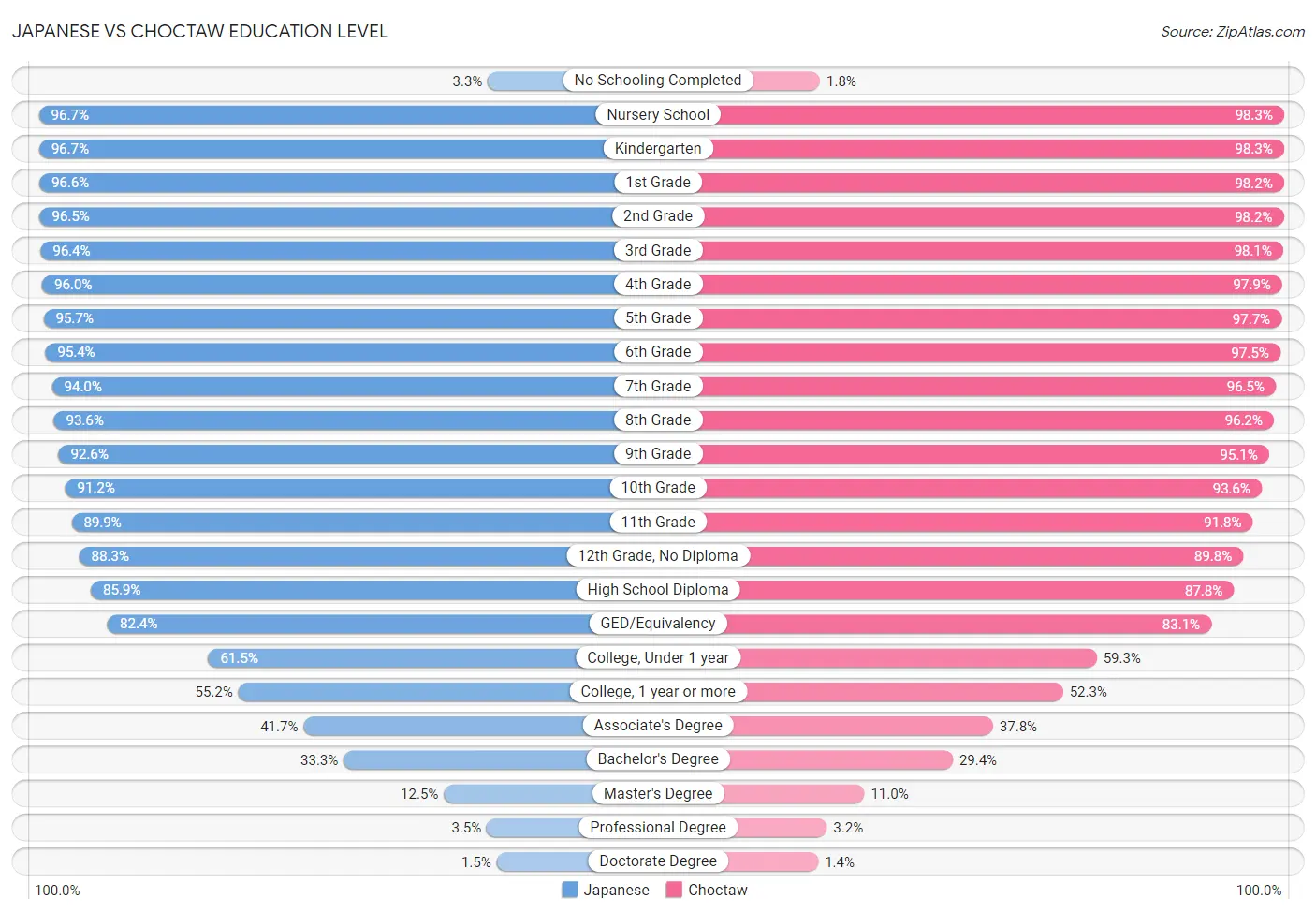
| Education Level Metric | Japanese | Choctaw |
| No Schooling Completed | Tragic 3.3% | Exceptional 1.8% |
| Nursery School | Tragic 96.7% | Exceptional 98.3% |
| Kindergarten | Tragic 96.7% | Exceptional 98.3% |
| 1st Grade | Tragic 96.6% | Exceptional 98.2% |
| 2nd Grade | Tragic 96.5% | Exceptional 98.2% |
| 3rd Grade | Tragic 96.4% | Exceptional 98.1% |
| 4th Grade | Tragic 96.0% | Exceptional 97.9% |
| 5th Grade | Tragic 95.7% | Exceptional 97.7% |
| 6th Grade | Tragic 95.4% | Exceptional 97.5% |
| 7th Grade | Tragic 94.0% | Exceptional 96.5% |
| 8th Grade | Tragic 93.6% | Exceptional 96.2% |
| 9th Grade | Tragic 92.6% | Excellent 95.1% |
| 10th Grade | Tragic 91.2% | Fair 93.6% |
| 11th Grade | Tragic 89.9% | Tragic 91.8% |
| 12th Grade, No Diploma | Tragic 88.3% | Tragic 89.8% |
| High School Diploma | Tragic 85.9% | Tragic 87.8% |
| GED/Equivalency | Tragic 82.4% | Tragic 83.1% |
| College, Under 1 year | Tragic 61.5% | Tragic 59.3% |
| College, 1 year or more | Tragic 55.2% | Tragic 52.3% |
| Associate's Degree | Tragic 41.7% | Tragic 37.8% |
| Bachelor's Degree | Tragic 33.3% | Tragic 29.4% |
| Master's Degree | Tragic 12.5% | Tragic 11.0% |
| Professional Degree | Tragic 3.5% | Tragic 3.2% |
| Doctorate Degree | Tragic 1.5% | Tragic 1.4% |
Japanese vs Choctaw Disability
When considering disability, the most significant differences between Japanese and Choctaw communities in the United States are seen in disability age under 5 (1.2% compared to 1.9%, a difference of 59.1%), hearing disability (3.0% compared to 4.5%, a difference of 51.3%), and vision disability (2.4% compared to 3.3%, a difference of 39.6%). Conversely, both communities are more comparable in terms of cognitive disability (18.3% compared to 18.4%, a difference of 0.97%), disability age over 75 (50.2% compared to 52.7%, a difference of 4.9%), and self-care disability (2.7% compared to 3.0%, a difference of 12.8%).
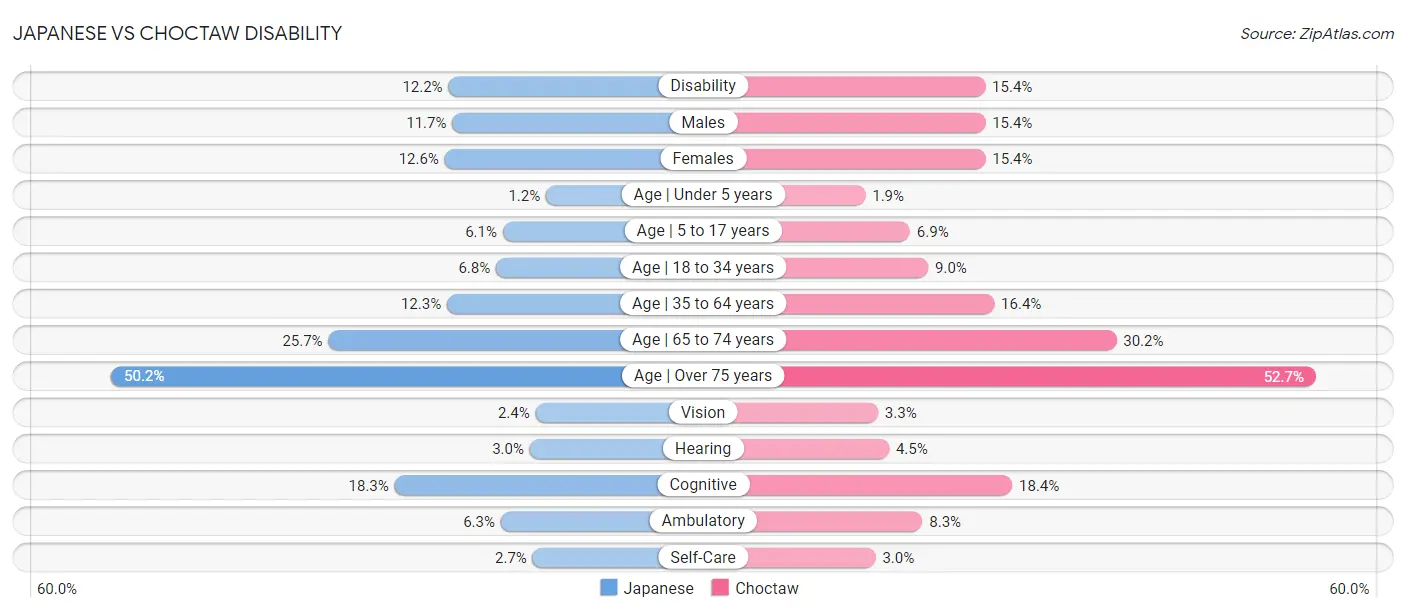
| Disability Metric | Japanese | Choctaw |
| Disability | Tragic 12.2% | Tragic 15.4% |
| Males | Tragic 11.7% | Tragic 15.4% |
| Females | Tragic 12.6% | Tragic 15.4% |
| Age | Under 5 years | Exceptional 1.2% | Tragic 1.9% |
| Age | 5 to 17 years | Tragic 6.1% | Tragic 6.9% |
| Age | 18 to 34 years | Poor 6.8% | Tragic 9.0% |
| Age | 35 to 64 years | Tragic 12.3% | Tragic 16.4% |
| Age | 65 to 74 years | Tragic 25.7% | Tragic 30.2% |
| Age | Over 75 years | Tragic 50.2% | Tragic 52.7% |
| Vision | Tragic 2.4% | Tragic 3.3% |
| Hearing | Average 3.0% | Tragic 4.5% |
| Cognitive | Tragic 18.3% | Tragic 18.4% |
| Ambulatory | Poor 6.3% | Tragic 8.3% |
| Self-Care | Tragic 2.7% | Tragic 3.0% |